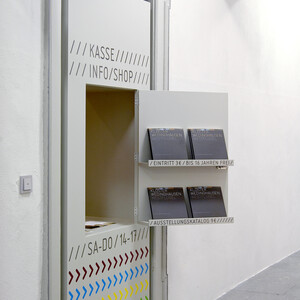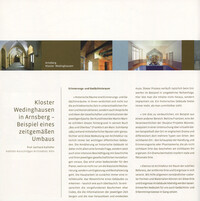
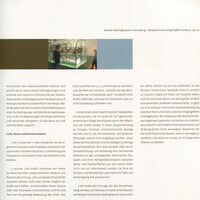
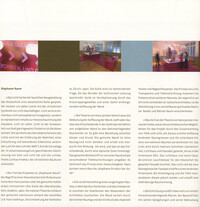
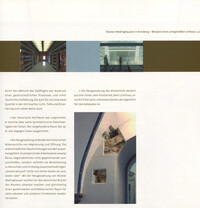
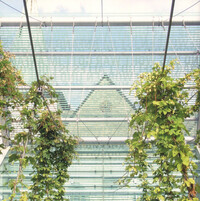
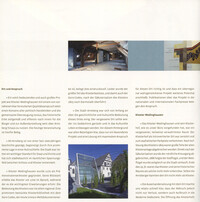
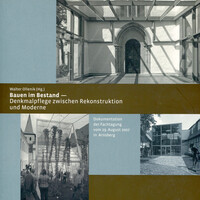
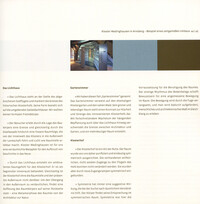
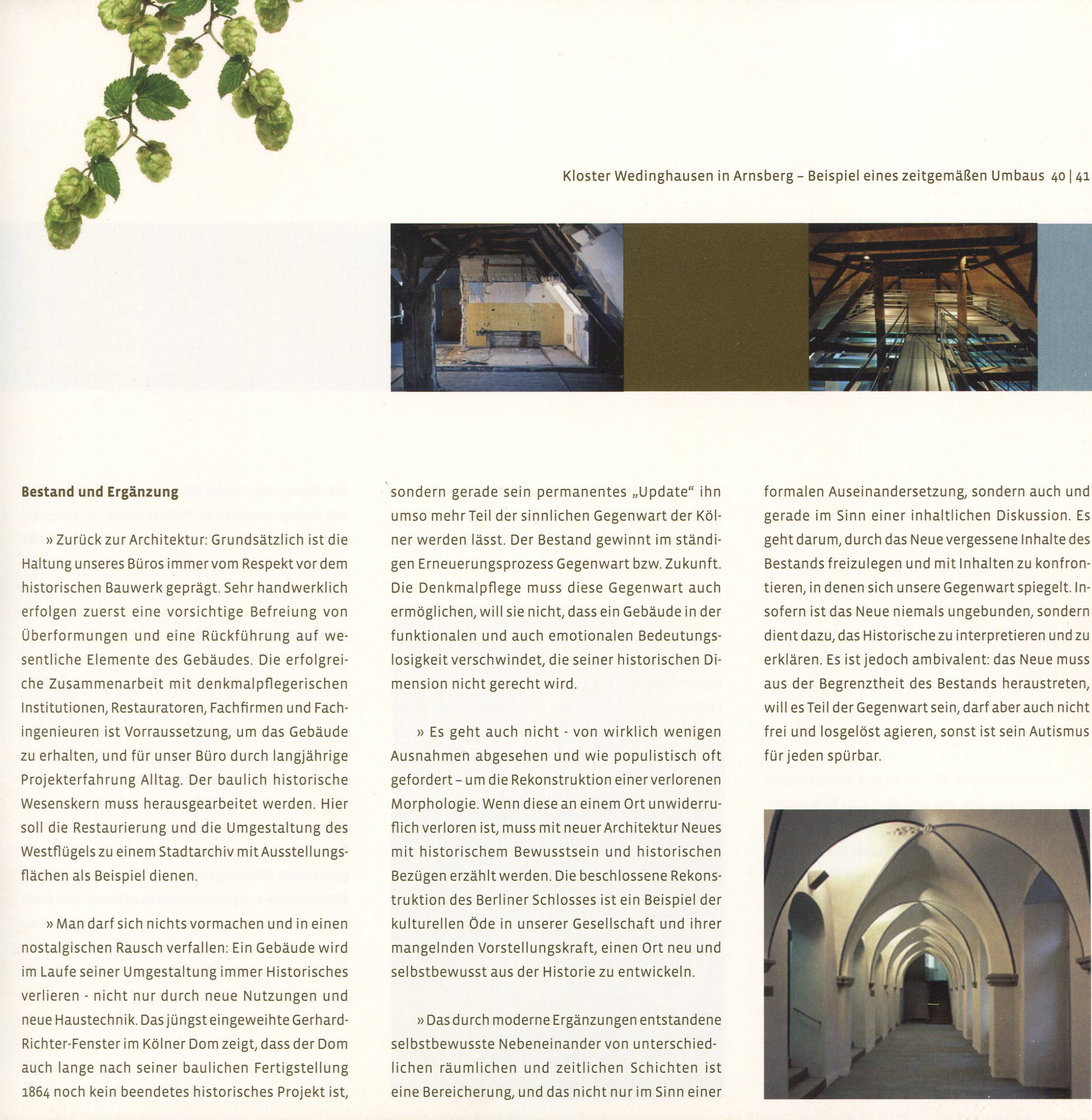
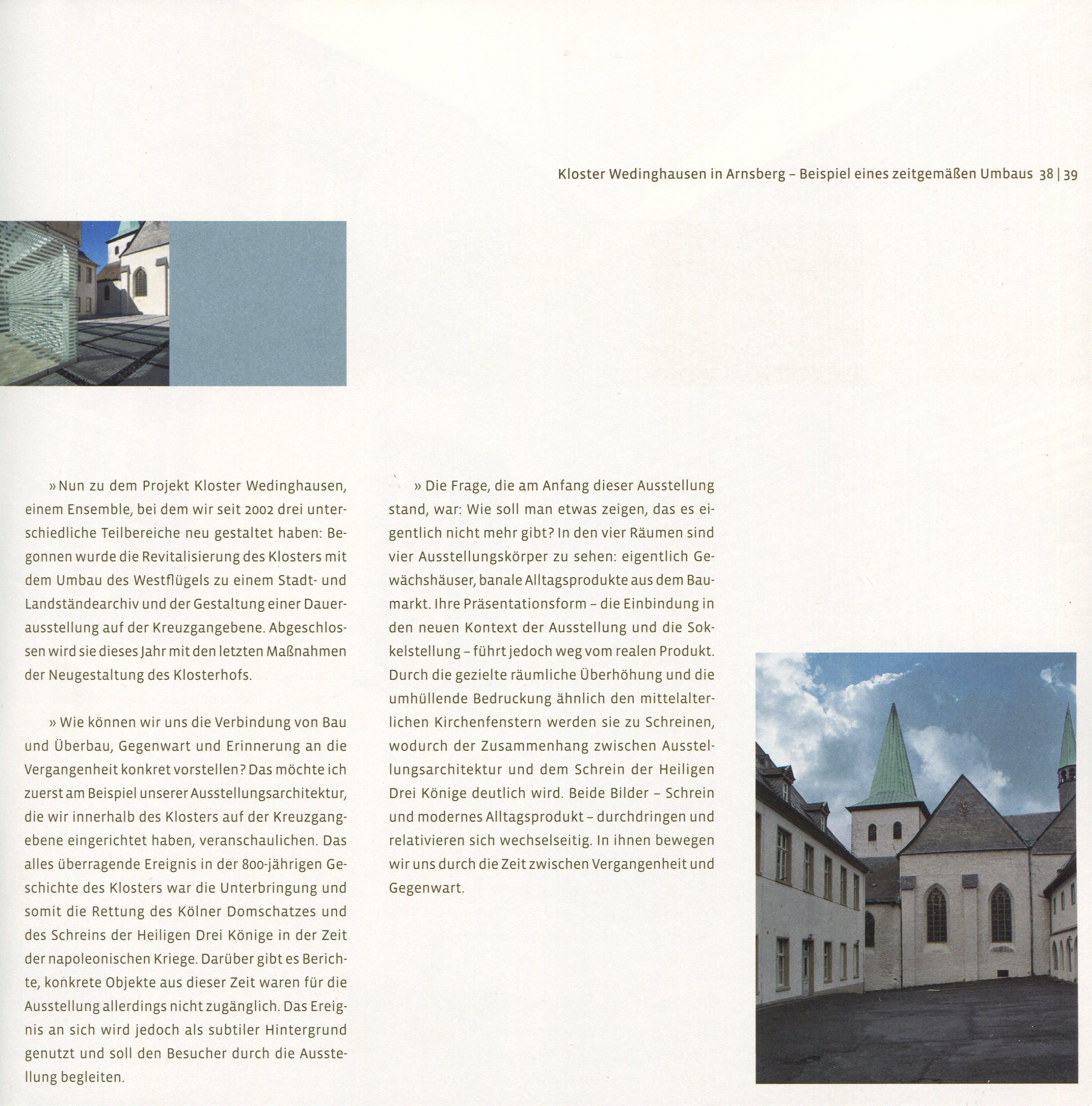
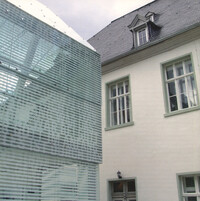
Contemporary Reconstruction Example: Monument preservation between reconstruction and modernity
Historical rooms are spaces of memory and remembrance. In them not only the architectural time is condensed in different forms and constructions, but also the demands and ideas of the societies and institutions of the respective epoch. The art historian Martin Warnke describes this background very precisely in his book Bau und Überbau (Frankfurt am Main: Suhrkamp 1984) using medieval buildings as examples. This meaning of architecture is of course always more poignant in the case of important public buildings. The approach to historical buildings is therefore not only a formal question, but also requires an intensive study of history and its respective social conceptions. This becomes all the more important for the planner when it is not only a matter of classical restoration, but also of supplementing and revitalizing. The main work is always an intellectual one at first: to recognize the essence of a building - structurally as well as superstructurally. Thus, the building forms found tend to correspond more to codes that contain the information of the time and that must be extracted and discovered. This process naturally runs in reverse order when designing within the existing building. Here one does not extract the contents, but implants them. A historical building always offers more than you can immediately see.
To illustrate this, an example from another area: Bettina Frantzen, one of those responsible for Skulptur Projekte Münster, in a study on virtual gardens, analyses the place in the English drama as an example and differentiates several types of places: the visible place - the scene of the action, and places of memory or fantasy, which as non-visible places complement the events at the visible place. A drama thus contains real and fictional places.
Likewise, architecture is a space of subtle reference that unites distant places and events. With the help of generally understandable coded forms and materials, we can make these places and events come alive in the building. For us, designing also means setting processes of memory and cognition in motion.
Now to the project Kloster Wedinghausen, an ensemble in which we have redesigned three different parts since 2002: The revitalization of the monastery began with the conversion of the west wing into an urban and rural archive and the design of a permanent exhibition on the cloister level. It will be completed this year with the final measures of the redesign of the monastery courtyard.
How can we concretely imagine the connection between building and superstructure, present and memory of the past? I would first like to illustrate this with the example of our exhibition architecture, which we have set up within the monastery on the cloister level.
The most outstanding event in the 800-year history of the monastery was the accommodation and thus the rescue of the Cologne Cathedral treasure and the shrine of the Three Magi during the Napoleonic Wars. There are reports about this, but concrete objects from this period were not accessible for the exhibition. However, the event itself is used as a subtle background and is intended to accompany the visitor through the exhibition.
The question that stood at the beginning of this exhibition was: how to show something that actually no longer exists? In the four rooms, four exhibition bodies can be seen: actually greenhouses, banal everyday products from the hardware store. Their form of presentation - the integration into the new context of the exhibition and the pedestal position - leads away from the real product, however. Through the deliberate spatial over-emphasis and the enveloping printing, similar to medieval church windows, they become shrines, which makes the connection between the exhibition architecture and the shrine of the Three Kings clear. Both pictures - shrine and modern everyday product - interpenetrate and relativize each other. In them we move through time between past and present.
Inventory and addition
Back to architecture: Basically, the attitude of our office is always characterized by respect for the historical building. In a very artisan manner, we first carefully free the building from over-shaping and return to the essential elements of the building. The successful cooperation with institutions for the preservation of historical monuments, restorers, specialized companies and engineers is a prerequisite for the preservation of the building. The structural historical core of the building must be worked out. The restoration and redesign of the west wing into a city archive with exhibition areas should serve as an example.
Man darf sich nichts vormachen und in einen nostalgischen Rausch verfallen: Ein Gebäude wird im Laufe seiner Umgestaltung immer Historisches verlieren - nicht nur durch neue Nutzungen und neue Haustechnik. Das jüngst eingeweihte Gerhard-Richter-Fenster im Kölner Dom zeigt, dass der Dom auch lange nach seiner baulichen Fertigstellung 1864 noch kein beendetes historisches Projekt ist, sondern gerade sein permanentes „Update“ ihn umso mehr Teil der sinnlichen Gegenwart der Kölner werden lässt. Der Bestand gewinnt im ständigen Erneuerungsprozess Gegenwart bzw. Zukunft. Die Denkmalpflege muss diese Gegenwart auch ermöglichen, will sie nicht, dass ein Gebäude in der funktionalen und auch emotionalen Bedeutungslosigkeit verschwindet, die seiner historischen Dimension nicht gerecht wird.
It is also not - with very few exceptions and as populists often demand - about the reconstruction of a lost morphology. When this is irrevocably lost in a place, new architecture must be used to tell new stories with historical awareness and historical references. The decided reconstruction of the Berlin Palace is an example of the cultural bleakness in our society and its lack of imagination to develop a place anew and self-confidently from history.
The self-confident juxtaposition of different spatial and temporal layers that has been created by modern additions is an enrichment, not only in the sense of a formal examination, but also and especially in the sense of a discussion of content. The point is to uncover forgotten contents of the inventory through the new and to confront them with contents in which our present is reflected. In this respect, the new is never unbound, but serves to interpret and explain the historical. However, it is ambivalent: the new must step out of the limitedness of the existing, if it wants to be part of the present, but it must also not act freely and detached, otherwise its autism will be felt by everyone.
Place and claim
Such an important and large project like Wedinghausen Monastery, with its clearly formulated quality standards from the outset, requires a consensus of all political actors and the common conviction that the historical heritage should be used in a contemporary and offensive way internally for the citizens and externally for presentation far beyond Arnsberg. Today’s event is proof of this.
Old Arnsberg is characterized by a history of almost 1000 years, favored by its prominent location in a Ruhr loop. The town has always been an important location for state and church and has developed urbanistically in the area of conflict between castle and monastery.
Kloster Wedinghausen was founded in 1170 as a Premonstratensian monastery. The monastery experienced its heyday around 1700 in the baroque era, during which it underwent the most important expansions. The importance of the monastery was never solely regional. A prominently equipped monastery library with the Gero Codex, which is today a Unesco World Document Heritage Site, is impressive proof of this. Unfortunately, most of the monastery property, and thus also the Gero-Codex, was transferred to Darmstadt after the secularization of the monastery in 1803.
The city of Arnsberg agreed on the historical and cultural importance of this place from the very beginning. The forgotten place should be brought back to memory and included in the cultural life. Against this background, it was clear to all those involved that only a special project and a solution with maximum standards was right for this place and that a project perceived as supra-regional would open up further potential. Publications about the project in the national and international trade press prove the claim.
Wedinghausen Monastery
Wedinghausen Monastery and its monastery courtyard, as our office found it, was a forgotten, partially neglected space. The Klosterhof as an introverted place had been destroyed and had degenerated into an asphalt parking lot. After the dissolution of the monastery in 1803, large parts of the old monastery complex had been demolished. Directly after secularization, the northern cloister was demolished, followed by the southern wing in 1886, and the western wing was sold to the city at the same time. By the end of the 19th century, the monastery and its historical rooms were no longer recognizable as such. Even the people of Arnsberg no longer knew the place as a monastery.
The examination of the site made it clear relatively quickly that the demolition, however, meant not only loss, but also departure for modernity. The opening of the monastery courtyard through the demolition of the south wing was an expression of a social process and a spatial enlightenment, which also brought a new quality to the place for us: light, depth and orientation to the nearby natural space.
The historical courtyard space was unfocused; its symmetry emphasized an equality of the sides. In contrast, the found space of the 19th century was linear.
The new design combines the historical contradictions of demarcation and opening. The different spatial directions were brought together. It corresponds to the working method of our office not to exclude opposites against each other, but rather to regard them as enrichment and bring them together in dialogue. For us, “as well as” is always better than “either, or”. With the redesign of Kloster Wedinghausen we wanted to make the spatial breaks of the monastery visible and at the same time restore a common architectural space for its sacral and profane functions.
The redesign of the monastery courtyard consists of three parts: the monastery courtyard, the light house, a kind of filter room, and a garden, which is actually part of the building.
The light house
The light house stands on the site of the demolished south wing and marks the boundary of the historic monastery courtyard. Its form refers to the surrounding gabled roof houses. We did not want a formal foreign body.
The visitor experiences a boundary through the location of the building and at the same time a linear sequence of rooms through the glass façade, leading from the inner world of the monastery to the outer world of the landscape, allowing light and spatial depth to be experienced. For us, Kloster Wedinghausen is a spatialized metaphor for the departure of history into the new.
The light house creates an ambivalent spatial feeling for the monastery courtyard:
- It is treated as a limited interior space.
- At the same time, the monastery courtyard is inconceivable without the depth of space and the presence of the exterior space.
In order to clarify the transition to the exterior space, a dissolution of the spatial body on its back takes place - a metamorphosis of space from architecture to nature.
Garden Room
We have called this part “Garden Room”. The Garden Room is a reference to the former monastery garden and the nearby forest. Its green and lively space contrasts with the clarity and austerity of the introverted monastery courtyard. As the hanging planting continues to grow, even beyond the light house, the boundary between architecture and garden disappears, and an ambiguous space emerges.
Cloister Court
The monastery courtyard is a place of peace. We have therefore purified the space and given it a clear symmetrical orientation. The existing arbitrary, non-axial accesses to the wings of the courtyard could not be changed. However, they were symmetrically integrated by new access ramps.
Symmetry always has a suggestive effect, which helps in the search for spatial understanding. The body finds its counterpart in symmetrical space. Symmetry was here the prerequisite for the calming of space.
The strict rhythm of the flooring creates awareness for appropriate movement in space. The movement is slowed down by the joint, and one is thereby encouraged to experience human and architectural dimensions in harmony.
Diaphane Room
Light played an essential role in the structural redesign of the monastery courtyard. We must therefore first deal with the Christian symbolism of light. Light is not used atmospherically in the church building, but it represents contents to illustrate faith.
Light is life. Light is equal to the presence of God; darkness is absence. The symbolism of the descent of light is connected with the experience of truth, an enlightenment and special knowledge (“I am the light of the world”). The light aesthetics/light architecture of Christian architecture has developed on the basis of the equation of God and light described in the Gospel of John.
The title of the project is “Diaphanous Space”. The term is taken from a theoretical writing of the art historian Hans Jantzen about Gothic cathedrals (Die Gotik des Abendlandes, Cologne, DuMont, 1962).
Most theories explain the Gothic sacred space on the basis of the vault (e.g. Hans Sedlmayr, Die Entstehung der Kathedrale, Zurich, 1950). Gothic becomes a constructive question that describes the miracle of technical achievement: Gothic is verticalization through the cross-ribbed vaulting and a consequent dissolution of the wall.
Although Hans Jantzen’s theory emphasizes the importance of the dissolution of the wall, it shows that the decisive factor in Gothic is the relationship between the dissolved wall and the parts of the room behind it. There is a relationship between body and ground. The Gothic wall is unthinkable without a room ground and only through this does it acquire its effect.
It is, and this is the decisive point, backed by an optical zone. The entire central nave is surrounded by a spatial shell of different depth layers. The principle of a double shell dominates. Hans Jantzen calls this the “diaphanous structure of the Gothic”.
The aim is to create a spiritualized space in which the translucence and immaterial glow of the glass windows form the essence of the architecture. The wall loses the impression of being materially solid and closed due to the light background. The principle of light, transparency and depth layering stages the presence of another room, which is actually not present at the location. Gothic architecture is the transition to an imaginable spiritual background. Real and fictional space become blurred.
What interested me in Hans Jantzen’s theory was the architectural possibilities for the project through the connection between depth and light, the resulting dissolution of concrete spatial boundaries, and the apparent presence of other spaces in the concrete location.
The light is guided through several layers (garden room, light house and facade) until it falls into the interior. The light house and its façade are a luminous body for the monastery courtyard. The entire façade is illuminated. The light and the new spatial boundary of the façade create a concrete interior space; however, the background and the depth transcend this again and create an ambiguous spatial effect.
The layering, however, does not just create rooms simply lying one behind the other. The building material glass with its reflections and its printing mixes the different levels and creates a temporal and spatial simultaneity of the levels through confusing overlays. These are blended in the dialogue between foreground and background, space and surface. Walter Benjamin speaks in this context of a transparency of penetration and overlapping in which the meanings of things oscillate and merge into one another. One and several pictures exist at the same time.
Light, space and communication
The incidence of light into the monastery courtyard is the real sensation of the project and emphasizes the spiritual character of the place. However, light effects and transparency are inconceivable without a façade image.
Today we understand signs and graphics as an enriching contemporary medium for structuring space - where this is not possible or difficult to achieve with architectural means. Graphics can help where architecture no longer has a chance.
On the one hand, writing and text underline the spiritual significance of the place. The quotation from John 1, 1-2, “In the beginning was the Word, and the Word was with God, and God was the Word. The same was in the beginning with God”, however, is not directly recognizable and is rather a mystery that is supposed to call for deciphering.
On the other hand, the principle of printing on the façade serves to bring the historical wings of the monastery, which have been separated over time, back into context through the rhythm of the graphics. However, formal architectural references could not be established through the various existing openings - rectangular windows and round arches have too little in common for this. The new façade establishes a horizontal reference to the surrounding historical façades and their brightness contrasts between wall and window surfaces through text compression and resolution. The text not only serves as information, but is also a kind of structure and relief substitute, making the depth and background vivid.
At the end of the lecture, which was intended to highlight the connection between construction and superstructure in historical buildings using the example of Kloster Wedinghausen, I would like to ask you not to make things too easy for the users of historical buildings by providing them with visuals only and concentrating on one room and its smooth, easily consumable beauty. It is about a much more intensive confrontation between form and content, between past and present. We have to shape the present from history, and in this respect we must not refuse to accept its dissonances and contradictions in terms of construction and content. Let us preserve the power of historical buildings without falling into nostalgia, and let us be courageous enough to aggressively enliven them with the present.
